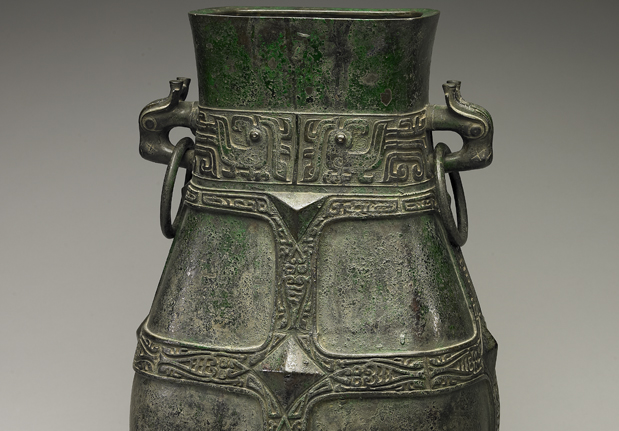Embedded hu jar, mid Western Zhou period, c. 10th-9th century BCE
- Image Number:K1A002132N000000000PAC
- DYNASTY:Western Zhou dynamity
- Category:Bronzes
- Function:ritual vessel, water vessel, wine vessel
- Material:Mineral/metal/bronze, Straight neck, bulging belly, with round feet leaning outward, and shallow platform near the bottom. On both sides of the neck, put animal head and ring ears. The neck is decorated with a symmetrical looking back phoenix, the belly is decorated with a cicada shaped cross band, and the feet are decorated with heavy ring patterns and diagonal cloud patterns. On the inner wall of the neck, there are four lines of 22 characters inscribed with two characters: “Zhou Zuo respected the pot on public days, which was used by the emperor, and its descendants will use it forever.” It shows that Zhou was the ancestor who made the tools to be used in the ancestral temple. He hopes that his descendants can use them for ever. On the premise that the Zhou people did not use the Japanese name and the national emblem, this week should not be the Ji surname. In contrast to the Gui and Pan made by Zhou Sheng, it may be the Zhou of Yun. Elliptical teapots became popular in the middle of the Western Zhou Dynasty, usually with a ring foot shaped cap. The cover of the device has been lost. According to the Western Qing Dynasty Ancient Manual, the inscription inside the cover is 6 lines, with the same number of words and contents as the device inscription. Volume A of Western Qing Dynasty Continuation

![图片[2]-Inscribed hu jar, mid-Western Zhou period, c. 10th-9th century BCE-China Archive](https://chinaarchive.net/Western Zhou dynasty/Bronzes/K1A002132N000000000PAC-4291.jpg)
![图片[3]-Inscribed hu jar, mid-Western Zhou period, c. 10th-9th century BCE-China Archive](https://chinaarchive.net/Western Zhou dynasty/Bronzes/K1A002132N000000000PAC-4292.jpg)
Pictures & Images [HD] download
© Copyright
The copyright of the article belongs to the author, please keep the original link for reprinting.
THE END





